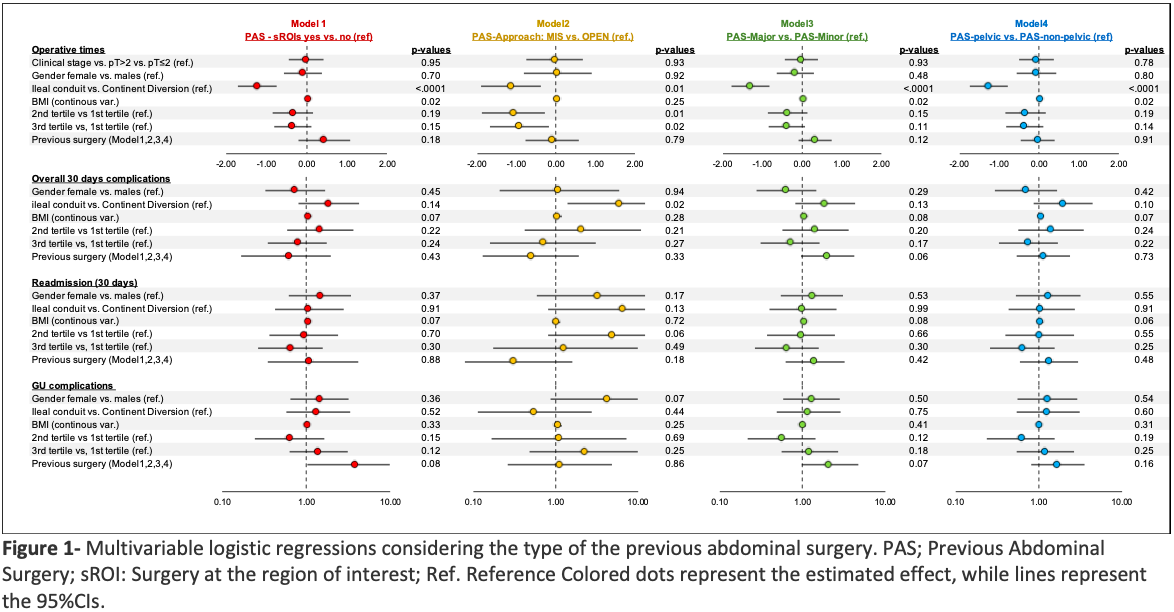Back
Introduction: Patients with prior lower abdominal/pelvic surgery are likely to have significant post-surgical intra-abdominal adhesions that may distort the anatomy. Such a “hostile” abdomen has been considered a relative contraindication for subsequent complex robotic urologic surgery, such as robotic radical cystectomy with intracorporeal urinary diversion (RRC-ICUD). Herein, we evaluated outcomes of patients undergoing RRC-ICUD with a history of prior lower abdominal/pelvic surgery stratified by type of previous abdominal insult.
Methods: From 07/2010 to 12/2021, 445 consecutive patients underwent RRC-ICUD for bladder cancer. Patients with previous abdominal surgery (PAS) were divided into 4 cohorts by PAS type: within surgical Region of Interest (sROI); pelvic vs abdominal; major vs minor; and approach of PAS [minimally invasive (MIS) vs open]. Outcomes of interest were operative times (OTs), overall 30-day complication rate, readmission rate and genitourinary (GU) complications. Multivariate analyses assessed impact of the type of PAS on the outcomes of interest (p < 0.05 significance level).
Results: Our cohort included a total of 445 patients: 266 with no PAS and 179 with PAS; 156 (89%) with PAS in sROI vs 19 (11%) with PAS not in sROI; 113 (64%) Major vs 63 (36%) Minor PAS; 82 (47%) with Pelvic PAS vs 93 (53%) with abdominal PAS; 22 (37%) with prior MIS vs 38 (63%) with open PAS. Oncologic outcomes: no significant differences between soft tissue positive margins amongst all 4 cohorts. Multivariate analysis: previous pelvic surgery and type of approach of PAS did not adversely impact perioperative outcomes (all p>0.05). PAS in sROI trended towards a higher overall GU complication rate (RR=3.8, p=0.08). Prior major PAS trended towards a higher 30-day complication rate (RR=1.9, p=0.06) and higher GU complication rate (RR=2.1, p=0.07). Across the models, BMI independently predicted longer OT (p=0.02)(Fig. 1).
Conclusions: In experienced hands, RRC-ICUD is feasible in a previously operated abdomen. However, patients with PAS in the sROI or major PAS should be counseled on a higher peri- and post-operative complication rate. Obese patients are likely to have prolonged operative times. SOURCE OF
Funding: NA

Moderated Poster Session
Session: MP56: Bladder Cancer: Invasive IV
MP56-11: Impact of Types of Previous Abdominal Surgery on Perioperative Outcomes in Patients Undergoing Robotic Radical Cystectomy with Intracorporeal Urinary Diversion
Sunday, April 30, 2023
9:30 AM – 11:30 AM CST
Location: S404C

Sij Hemal, MD
Cleveland Clinic Glickman Urological and Kidney Institute
Poster Presenter(s)
Introduction: Patients with prior lower abdominal/pelvic surgery are likely to have significant post-surgical intra-abdominal adhesions that may distort the anatomy. Such a “hostile” abdomen has been considered a relative contraindication for subsequent complex robotic urologic surgery, such as robotic radical cystectomy with intracorporeal urinary diversion (RRC-ICUD). Herein, we evaluated outcomes of patients undergoing RRC-ICUD with a history of prior lower abdominal/pelvic surgery stratified by type of previous abdominal insult.
Methods: From 07/2010 to 12/2021, 445 consecutive patients underwent RRC-ICUD for bladder cancer. Patients with previous abdominal surgery (PAS) were divided into 4 cohorts by PAS type: within surgical Region of Interest (sROI); pelvic vs abdominal; major vs minor; and approach of PAS [minimally invasive (MIS) vs open]. Outcomes of interest were operative times (OTs), overall 30-day complication rate, readmission rate and genitourinary (GU) complications. Multivariate analyses assessed impact of the type of PAS on the outcomes of interest (p < 0.05 significance level).
Results: Our cohort included a total of 445 patients: 266 with no PAS and 179 with PAS; 156 (89%) with PAS in sROI vs 19 (11%) with PAS not in sROI; 113 (64%) Major vs 63 (36%) Minor PAS; 82 (47%) with Pelvic PAS vs 93 (53%) with abdominal PAS; 22 (37%) with prior MIS vs 38 (63%) with open PAS. Oncologic outcomes: no significant differences between soft tissue positive margins amongst all 4 cohorts. Multivariate analysis: previous pelvic surgery and type of approach of PAS did not adversely impact perioperative outcomes (all p>0.05). PAS in sROI trended towards a higher overall GU complication rate (RR=3.8, p=0.08). Prior major PAS trended towards a higher 30-day complication rate (RR=1.9, p=0.06) and higher GU complication rate (RR=2.1, p=0.07). Across the models, BMI independently predicted longer OT (p=0.02)(Fig. 1).
Conclusions: In experienced hands, RRC-ICUD is feasible in a previously operated abdomen. However, patients with PAS in the sROI or major PAS should be counseled on a higher peri- and post-operative complication rate. Obese patients are likely to have prolonged operative times. SOURCE OF
Funding: NA

